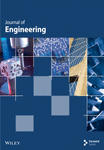Optimization of Ultrasonic Welding Parameters for Superior Wire Terminations
Abstract
This research focuses on optimizing ultrasonic welding parameters to enhance wire terminations, which are crucial for automotive electrical systems. Using response surface methodology with a Box–Behnken design, we systematically evaluated key parameters amplitude, air pressure, welding time, weld bond height, and weld bond width to maximize tensile strength and minimize electrical resistance. Optimal settings were identified: an amplitude of approximately 19798 Hz, air pressure at 5 MPa, and welding time of 5 s, resulting in high tensile strength and superior weld quality, with desirability scores of 0.9909. Significant factors affecting peel and pull forces were amplitude, welding time, and weld bond width, while air pressure and weld bond height were less critical. Further experiments confirmed the reliability of these optimal settings, matching predicted values. SEM micrographs provided detailed visual confirmation, showing complete bonding on both sides of the die ridge, thus ensuring the integrity and strength of the ultrasonic welds. These findings underscore the importance of precise parameter control in ultrasonic welding, contributing to improved practices in the automotive and other manufacturing industries.
Conflicts of Interest
The authors declare no conflicts of interest.
Open Research
Data Availability Statement
The data used to support the findings of this study are included in the article.




